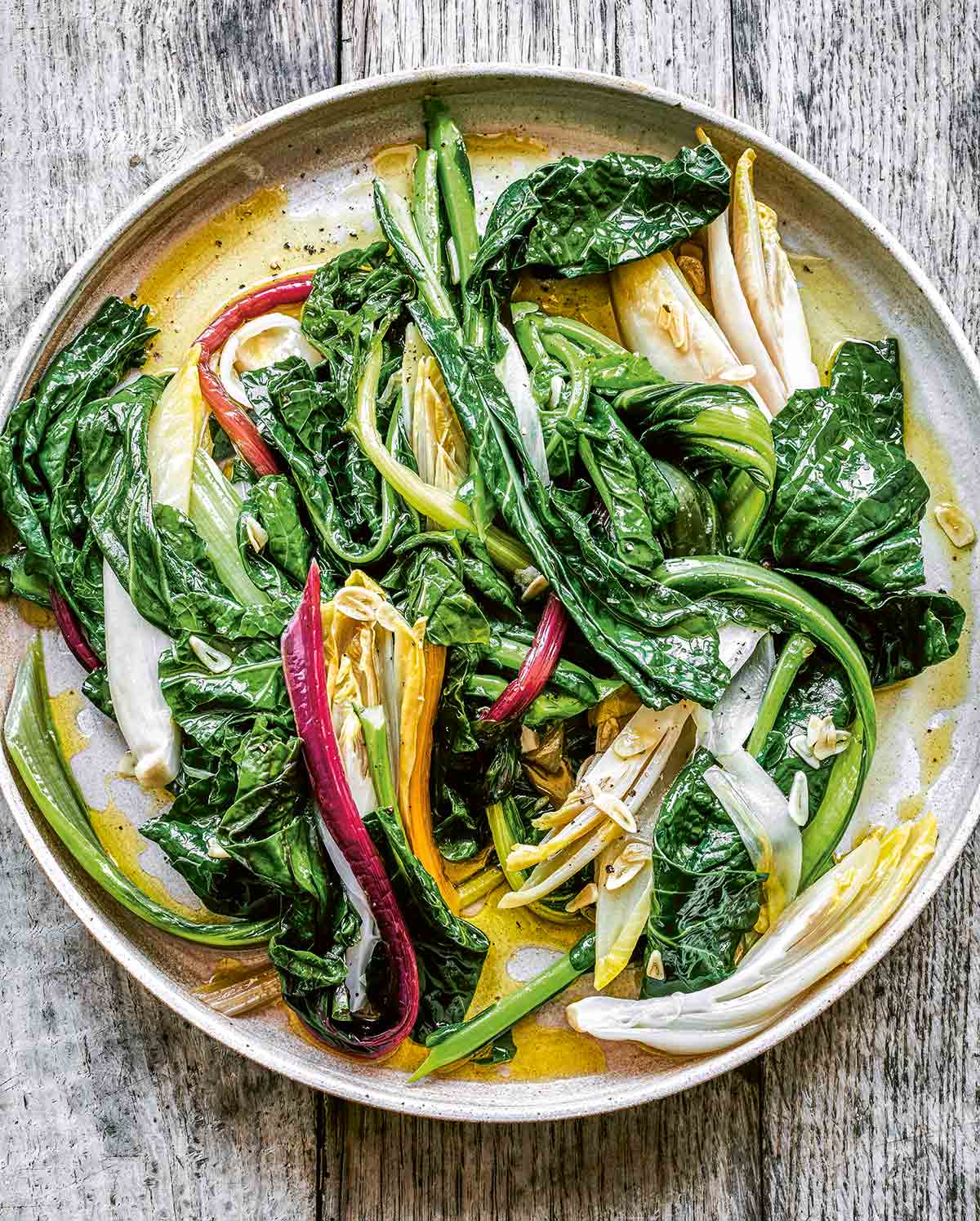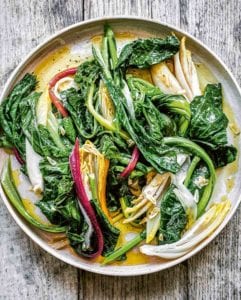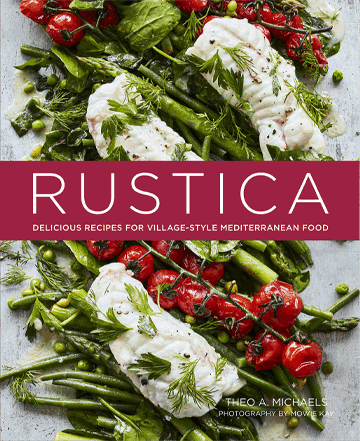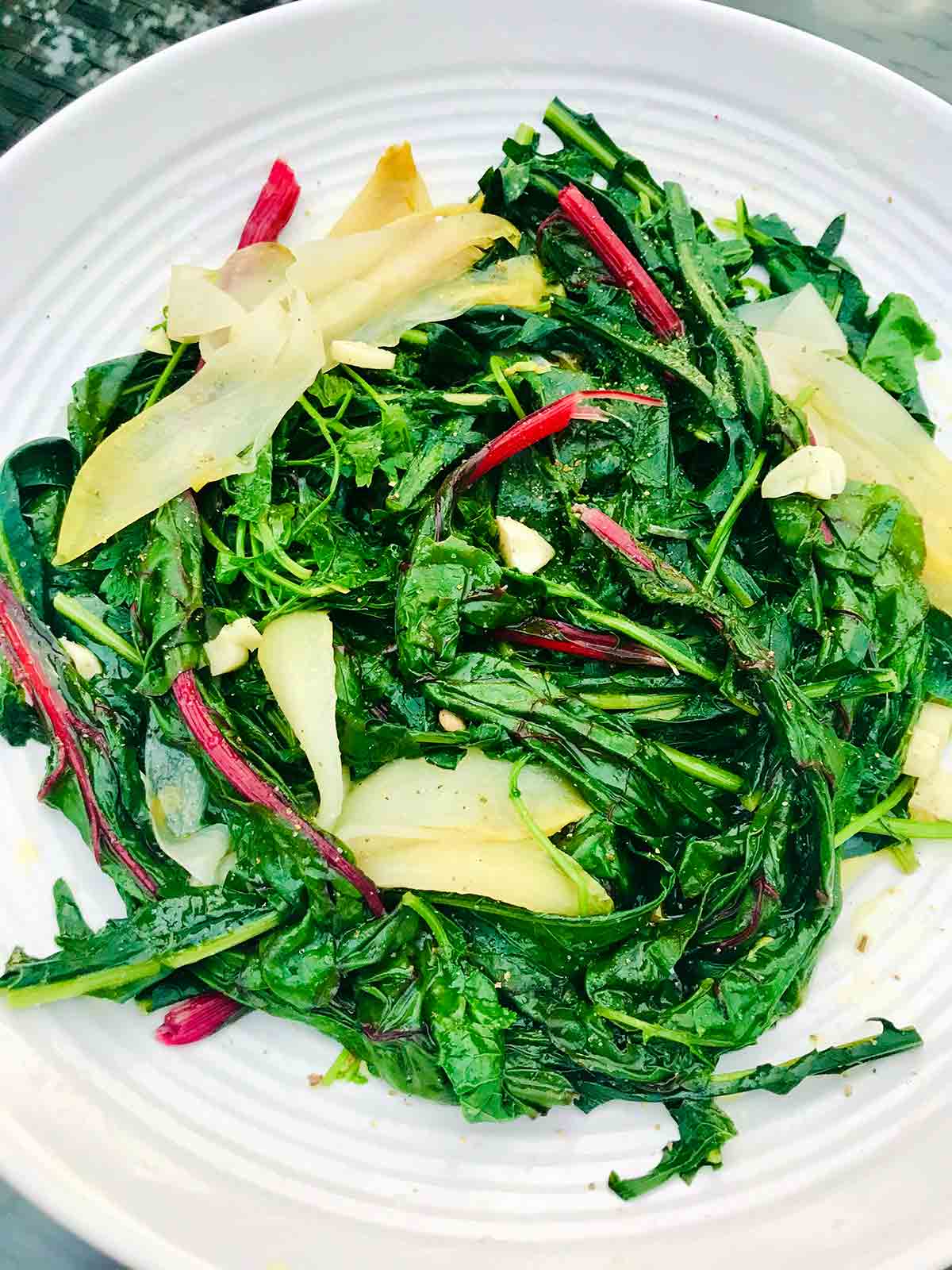
Horta vrasta translates as boiled wild greens. If you can get wild garlic or dandelion leaves, by all means include them, as this recipe is about using any edible, foraged wild green. My recipe includes a good dose of warm, garlic-infused extra virgin olive oil for a little extra goodness and punch of flavor.–Theo A. Michaels
Want to Save This?

Horta ~ Boiled Greens with Garlic
Ingredients
- 1 cup extra virgin olive oil
- 2 garlic cloves, thinly sliced
- 18 ounces any young leafy greens, such as dandelion greens, kale, turnip tops, collard, and/or cabbage
- 14 ounces rainbow Swiss chard
- 9 ounces white Belgian endive or chicory
- A large handful of flat-leaf parsley sprigs
- Freshly squeezed juice of 1 lemon
- Salt and freshly ground black pepper, to season
Instructions
- In a small saucepan over low heat, warm about 1/3 cup of the oil along with the sliced garlic just long enough for the garlic to infuse the oil, 3 to 5 minutes. Take care not to let the garlic turn golden.
- Remove the pan from the heat and pour in the remaining oil.
- Trim any very thick stalks from the young greens and Swiss chard. Let the rest of the stalks and the leaves whole. Trim the root end from the Belgian endive and toss them in the compost. Quarter each endive lengthways.
- Bring a large saucepan of salted water to a boil and drop in the young greens and chard and simmer until the stalks are soft but not mushy, 3 1/2 to 8 minutes, depending on how sturdy your greens.
☞ TESTER TIP: If you’d like to use some of the thick stalks, add them to the boiling water about 2 minutes before the rest of the greens.
- Use a slotted spoon to remove the greens to a colander to drain. Add the whole sprigs of flat-leaf parsley and chicory to the same water and simmer for about 3 minutes before transferring to the colander.
- In a large serving bowl, gently combine the cooked greens, the garlic-infused oil, and lemon juice, and season with salt and pepper.

Explore More with AI
Nutrition
Nutrition information is automatically calculated, so should only be used as an approximation.
Recipe Testers’ Reviews
In order to like this, you have to be a fan of bitter greens. I am, but unfortunately no one else in my family is. Bitterness is a very divisive thing, especially if your family is peppered with “super tasters.”
I liked most of the mix of bitter greens I managed to get: young dandelion greens, red chard, baby kale, and Belgian endive. I could have happily left out the Belgian endive (although it looked pretty) and swapped in chicory but I couldn’t find any. And I could only find red chard instead of rainbow which would have looked even more beautiful, but it still tasted great (although chard always has that very vegetal earthy taste that some people find off-putting. I kind of dig it!).
That said, I thought this was good and with a little help could have been great.
The recipe calls for the garlic to be just warmed through but not cooked at all. I thought the garlic flavor would have permeated better if it had been chopped more finely instead of sliced and cooked for a few minutes longer. I also thought it would have benefitted from a few dashes of red chili flakes.
The recipe called for blanching the greens for EIGHT MINUTES, and there was just no way I was doing that. I blanched all of them for 3 1/2 minutes and I thought it was plenty. The greens still had some bite but weren’t tough. The stems weren’t quite cooked through, but I like it when they fight me back a little bit. In addition to cooking the garlic a little longer, I think a better scenario would have been to leave the garlic and oil in a pan, then add the blanched, drained greens to the pans and sauce them for a few more minutes in the garlicky oil, similar to the way I make broccoli rabe.
I felt infused with health after eating this; I think if I just stick with baby kale (so friendly, so innocuous, so available) instead of the other greens, I might even be able to get my family to eat it too!

Horta vrasta translates as boiled wild greens but “horta” also translates as vegetable garden in Portuguese and Spanish. I pretty much just walked into my “horta” and returned with a basketful of greens in all different shades, sizes, and levels of tenderness and bitterness. Each variety alone would not have created a dish but together with this recipe created a most pleasurable offering of greens. I had dinosaur kale, collards, radish and turnip tops, bok choy, endive, chard, borage, wild garlic, and parsley. It was a green fest!
The garlic oil was genius as was the final lemon juice. Enjoyed my finished greens with smoked chicken legs and it was a perfect combination! Snuck some leftovers in my lunchbox and was thoroughly surprised that they were still amazing warmed up in the microwave—minus the brassica smell. Go ahead, make me eat my green leafy veggies!
For this horta, I used Chinese cabbage, turnip greens, beet greens, collards, and of course the mustard greens!!! This horta recipe is extremely simple to follow and the final result is beyond amazing. I served it with Steamed Cod with Ginger and Scallions. A few of us actually thought it reminded us of the tastes of Trás os Montes where people boil the veggies and also warm the garlic in olive oil then serve it with fried eggs and alheiras (a type of non pork sausages).












